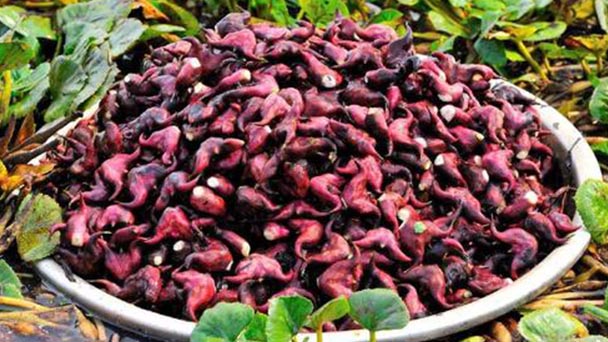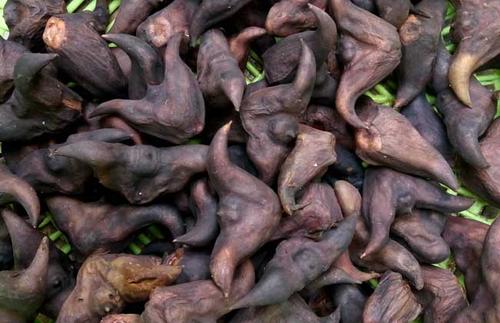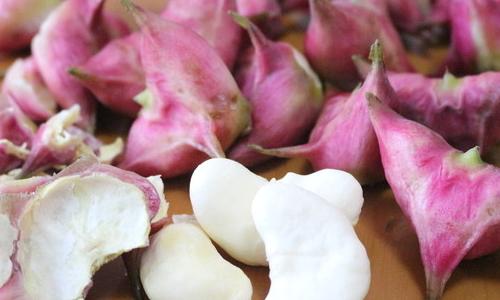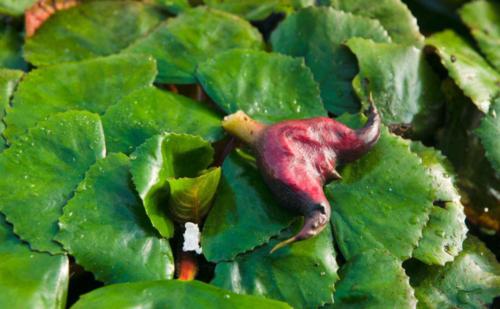Water chestnut profile
Written by Maggie
Dec 19 2020

Water Chestnut is an annual aquatic herb. Root type 2: thin iron wire shaped root; Assimilate root pinnatifid, stem weakly branched. Type 2: Alternate floating leaves, rosettes, oblate or wide rhomboid leaves, serrate in the middle and upper part, dilated balloon in the middle stalk, small submerged leaves, early falling. Flowers are small, solitary in leaf axils, white. Water Chestnut has nutlike ingot, with 4 recurved horns, often red.Distributed south of the Yangtze River in China.
Water Chestnut picture

Water Chestnut form features
Water Chestnut is an annual floating leaf aquatic plant of the Chestnut family. The stems, leaves and fruit are quite special. Taproot is weak, about a few feet long into the water bottom mud, fixed plants, absorption of nutrients, slender stems and stems completely submerged in the water. There are branches and "mustang" can also play the role of absorption. There are two kinds of leaves, which aggregate on the condensed stem and rise to the surface of the water. They are called floating leaves, inverted triangles, and inlaid into a disc, commonly known as a rhombus. Each rhombus has 40-60 leaves, with thick and fat petioles, and the middle part is expanded into an air sac, so that the leaves can float on the water.
In the axils of leaves in late summer and early autumn, there is a small flower, white or red and white. After fertilization, the flower will bend downwards and sink into water to grow into fruit, which is called "Water chestnut". The hard horns of water chestnuts are divided into hornless water chestnuts, triangular nuts and four-horned water chestnuts according to the number and presence of water chestnuts. Young fruit color is green, red or purple, ripe hard shell into black, pulp milky white, edible part for the seeds of the hypertrophic cotyledon.
Great for rivers and pools, Water Chestnuts are high in nutritional value and contain many vitamins and minerals. The rhombus develops about 40 cm. About 40 leaves were harvested. Leaves are small, 5.6 cm long and 7.7 cm wide, rhombic, bluish green, purplish red near petiole. The leaf surface, petiole and stem are all maroon, petiole is 22 cm long.
Flowers are white, sepals longer. The results of a single rhomboid plate were 7 ~ 8. The fruit has 4 horns. The shoulder Angle is slender and flat, the waist Angle is slightly downward sloping, the fruit is 2.8 centimeters high and 3.2 centimeters wide, bright red, and weighs 14 grams per kilogram, 50 ~ 70 pieces per kilogram. Water Chestnut is crisp and juicy, sweet and good quality. Water Chestnut is not resistant to deep water, not against the wind, only suitable for shallow water cultivation. The yield per acre is about 500 kilograms.

Water Chestnut growing environment
Water Chestnut likes warm and moist, sufficient sunlight, frost resistance, from sowing to harvesting takes about 5 months, the result period is long 1-2 months, so requirements of the frost-free period are more than 6 months in order to get a high yield. Flowering and fruiting stage requires daytime temperature 20-30℃, night temperature 15℃.
Water Chestnut is widely available in the two lakes, two rivers, and other regions of the freshwater watershed. There are both wild and artificial varieties. Water Chestnut has small wild fruit, large artificial fruit. The wild fruits can be picked in the light summer season and eaten raw, and the old fruits can be picked and cooked after the autumn equinox. The petiole, vein and pericarp were all water red. The fruit shape is large, 25 ~ 35 per kilogram, the shoulder Angle is slender and flat, the waist Angle is medium long, slightly downward sloping, the ratio of fruit weight to meat weight is about 1.5:1.No water, no wind.
Water Chestnut distribution range
Water Chestnut is originally from Europe, and then introduced to south China, distributed in Jiangsu, Zhejiang, Jiangxi, Fujian, Hubei, Hunan, Guangdong and Taiwan provinces. Especially in the middle and lower reaches of the Yangtze River, the Taihu Lake area and the Pearl River Delta.
The main value of Water Chestnut
Nutrition, taste and function are similar to chestnut chestnut. Per 100 grams of red water chestnut contains 2.6 grams of protein, 0.3 grams of fat, 14.3 grams of sugar, 70 kcal, 22 mg of calcium, 121 mg of phosphorus, 1.1 mg of iron.
It can be either a fruit or a staple food. The tender red water chestnut is extremely refreshing and can relieve heat and thirst. When going out to play, eat some fresh red water chestnut, can play the role of relieving thirst, and relieve fatigue. However, be sure to clean the raw Water during the chestnut meetings so that the Water chestnut husk will not contain any pesticide or any bacteria or viruses.
Water Chestnut can be used for waterscape decoration and landscaping in parks, ponds and scenic areas; The seeds contain starch and are edible.

Latest Updated
- Benefits of Bugleweed - 7 Science-backed Health Benefits
- Bugleweed Dangers & Side Effects - Is It Poisonous?
- How to Plant Evergreen Trees - What You Should Know
- When to Plant Evergreens - Grow Guide for Evergreen Trees
- 12 Wonderful Evergreen Shrubs for Your Garden
- 12 Popular Evergreen Plants with Pictures for Beginners
- When And How To Prune A Lilac Bush Like a Pro
- How to Grow & Care for Lilac Vine (Hardenbergia Violacea)
- Japanese Lilac Tree (Syringa Reticulata) Care & Propagation Guide
- Shumard Oak Pros and Cons - What to Know
Popular Articles
- Winter maintenance of Antirrhinum Majus
- How to Grow Terminalia Mantaly Tree
- How to Grow and Care for Crossostephium Chinense
- How to grow Antirrhinum Majus in spring
- Peristeria Elata (Dove Orchid) Profile: Info & Care Guide
- Underwatered Snake Plant (Sansevieria Trifasciata) - Signs And How To Fix
- How to Care for Brazilian Jasmine Plant (Mandevilla Sanderi)
- How to Grow & Care for Graptopetalum Purple Delight in Summer
- Rosa Chinensis (China Rose): Plant Growing & Care Tips
- How to Care for Baby Sun Rose (Aptenia Cordifolia)